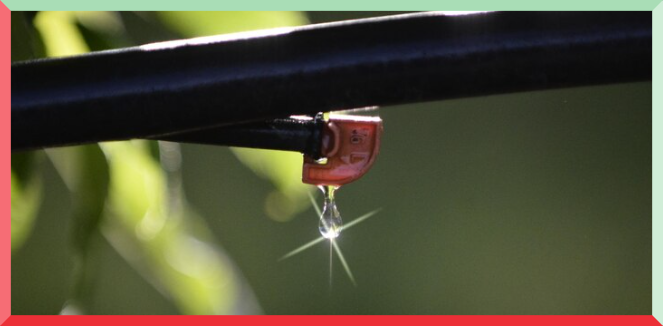
Drip irrigation stands out as one of the most efficient methods for watering plants.
This customizable technique uses significantly less water compared to other irrigation methods, delivering moisture directly to the plant roots. At the heart of this system are drip emitters, which ensure precise water delivery.
With various types of emitters available, choosing the right one is crucial to prevent water wastage and save money.
Here Is the List of Different Types of Emitters
Point Source Emitters
Point source emitters provide the water to the base of the plant either online by installing an extra small pipe and attaching the emitter or integrated with the drip line.
These emitters release the water at a single point through a small opening.
Online Emitter
Online emitter attached separately to the main tubing via punch or clamp connection.
These are adjustable and easily replaced if clogged. Common flow rates are 1, 2, and 4 gallons per hour.
Integrated Emitter
Integrated emitters are built into the drip tube at set intervals during manufacturing.
They provide uniform watering but are not adjustable or replaceable. Flow rates typically range from 0.5 to 2 gallons per hour.
Turbulent Emitters
These emitters force water to flow in a twisted labyrinth path creating a turbulence to slow down the water.
Twisting paths and turbulence help prevent clogging.
There are several types of turbulent emitters.
Vortex Emitters
For maximum turbulence these emitters create a vortex to propel the water through a spiral path.
They have ruffly low flow rates, around 0.5 gallons per hour.
Bubbler Dripper
Bubbler emitters work like the vortex emitter, but the difference is Bubbler creates a gentle umbrella pattern, while vortex drippers emit water in a steady circular pattern.
Long Path Emitters
To slow the water flow, these emitters have a longer spiral channel.
Flow rates range from 0.5 to 2 gallons per hour.
Mazzei Emitters
Mazzei emitters are named after the Mazzei injector company.
Mazzei emitters use a venturi and spiral chamber to create turbulence.
These emitters have flow rates from 0.5 to 3 gallons per hour.
Pressure Compensating Emitters
These kinds of emitters maintain the same water output even when water inlet pressure varies.
Pressure compensating emitters use a flexible rubber diaphragm to maintain a steady flow rate across a range of water pressures. This helps prevent too much water output at high pressures.
Flow Control Drip Emitters
In this type of emitter, the flow path is controlled by the diaphragm flexing in response to changes in water pressure.
Pressure Compensating Online Emitter
These are the emitters used in areas like slopes and where changes in elevation.
Pressure compensating emitters regulate pressure for add-on emitter lines.
Micro Spray Jet Emitters
Micro spry jet emitters spray the water into the air in various patterns.
Unlike the other emitters on the list, micro spray emitters disperse water over a broader diameter and are available in patterns such as 90, 180, or 360-degree arcs. They are ideal for watering large areas, such as crawling ground cover.
Mister and Fogger Emitters
Mister and Fogger emitter used for watering the delicate plant.
These emitters spray water like fine mist, providing an air cooling effect.
Subsurface Point Source Emitters
Similar to point source emitters, these deliver water through buried drip pipes.
These rugged emitters supply water underground through a secondary tubing system with discharge points at plant root zones.
Flag Emitter
Flag emitters have the flag on the top, which shows the flow rate of the emitter. If necessary, they can be taken apart to clean the emitter if it is clogged from the minerals in the water. Despite their resemblance to the little inline valves, turning the flag on top will not regulate water flow.
You can directly install them on the main line by using a drip punch tool. Or they can attach the micro tubing to your flag dripper and use a stake to direct the water flow.
Button Dripper
The button dripper is like a Flag emitter, but the difference here is it does not have the flag to clean or show the flow rate.
Instead, these drippers come in a variety of colors that define the flow rate and have small throttles, assuring that a uniform rate of flow is discharged. The emitter reduces and regulates the amount of water discharged. And you can use these drippers on the main drip line or attached to the micro tubing.
Final Thoughts…
Understanding the various types of drip emitters enables you to design an efficient irrigation system tailored to your plants and site conditions.
With thoughtful selection and proper installation, drip irrigation can become a water-wise gardening solution.
So, which emitter type is best suited for your needs? Let us know in the comments below!

Leave a Reply